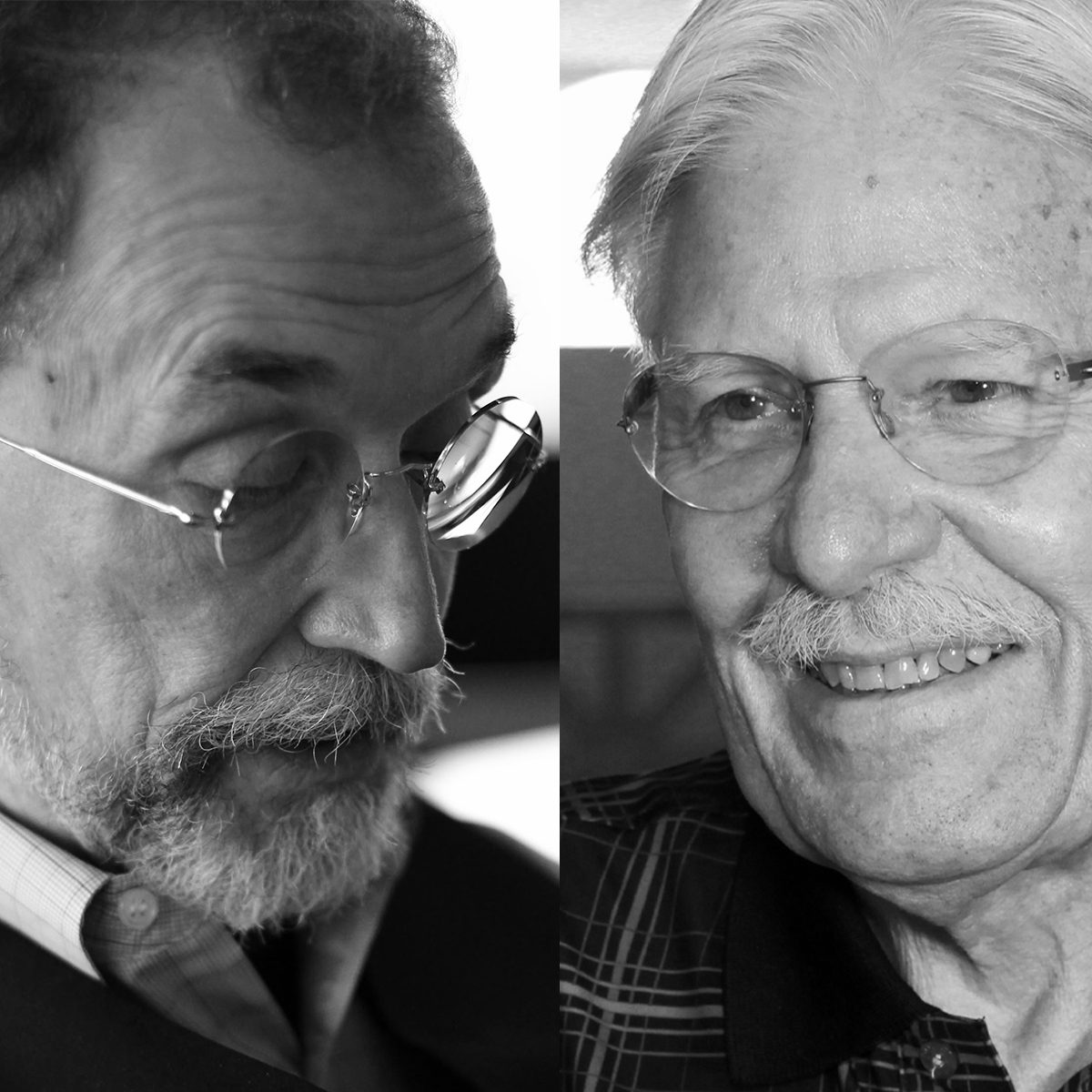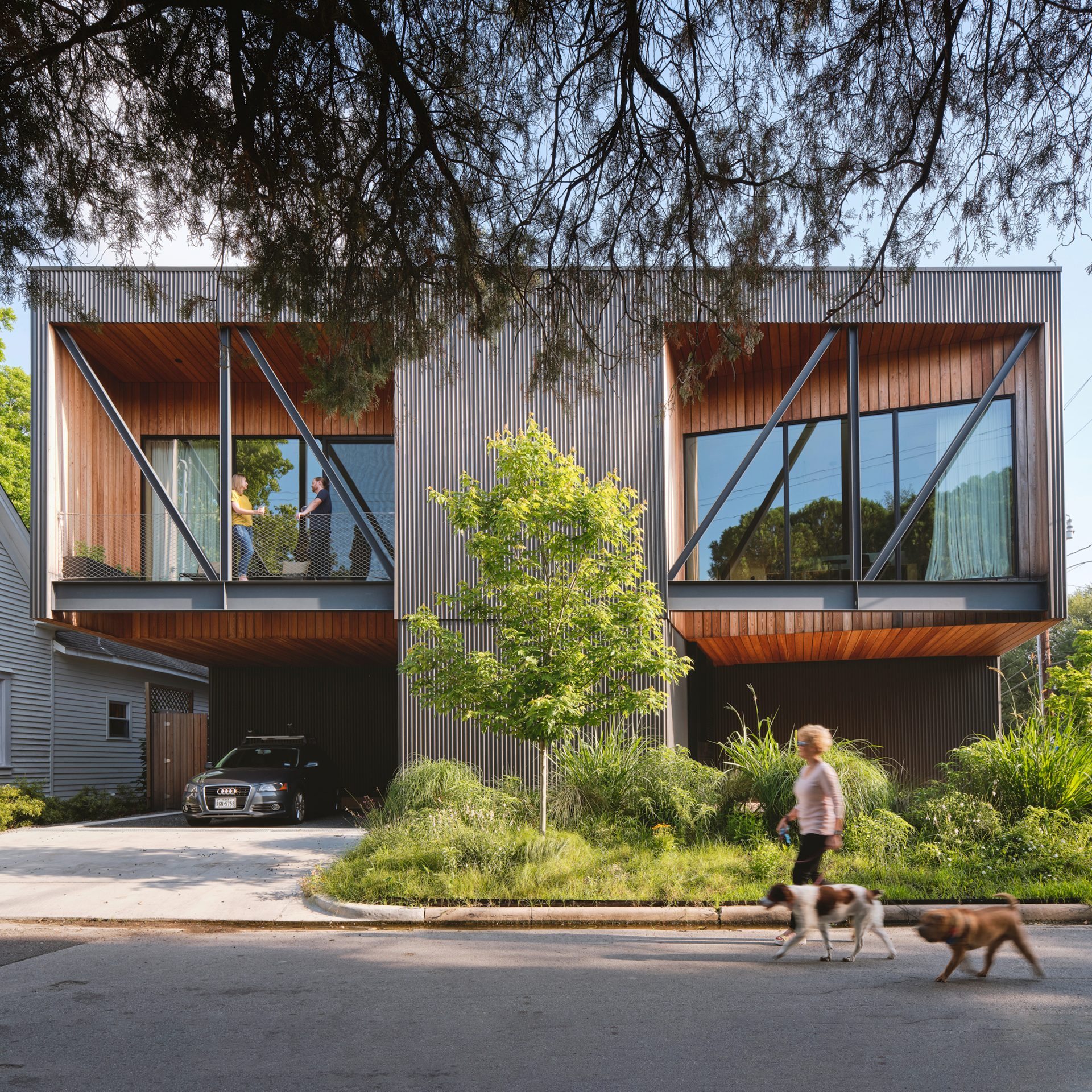
Coming Full Circle
Network brings together unexpected collaboration reinventing tradition
by Stephen Schad • May 30, 2023
In January, Dijana Handanović (M.Arch. ’15, B.F.A. ’09) found herself outside the University of Houston Blaffer Art Museum, supported by her husband and Hines College colleagues, digging a forklift out of the mud. For many, this would have been a bad omen for what was yet to come during the upcoming spring semester; however, for Handanović, it was the start of something extraordinary.
The Kiosk K67
On this particular winter morning, Handanović, an assistant professor in interior architecture, was installing a kiosk for her new exhibition. Originally from the former Yugoslavia, Handanović had taken a personal interest in the Kiosk K67 popular in her home country. Designed in 1966 by architect Saša Janez Mächtig, only about 7,500 kiosks were produced before production halted in 1999. Following the Yugoslav Wars in the 1990s, only a small number of kiosks remained, and most were in terrible condition. In their prime, the kiosks were often used as newspaper stands, coffee shops, post offices, and other everyday purposes.
Handanović made it her mission to acquire several kiosks and restore them to their former glory. She refurbished three of the four kiosks she attained in Bosnia and shipped them to the United States. Because the kiosks had such a connection to Handanović as a child, it was meaningful for her to bring this part of her youth to life and sustain the architectural value of the kiosks.
“For me, the kiosk is a moment creating a pause in an urban setting,” said Handanović. “It allows people to gather around something unique yet common and come together.”
The kiosk installation helped Handanović provide her students with a visible example of the importance of carrying traditional architecture into a modern context. The Kiosk K67 exhibition opened at Blaffer Art Museum on January 26, showcasing the history of the kiosks and immersing visitors in a cultural experience, including original music composed by Kathrine G. McGovern College of the Arts students inspired by the kiosks.
Yet, how could Handanović further impress upon her students the importance of bringing traditional, cultural design into our present world?
above: Handanović poses with the Kiosk K67; images from the exhibition's opening night where the kiosk was used to serve refreshments to guests
Making the Connection
Alumnus Adam Spencer Cook (B.Arch. ’11, B.S. ’11, B.B.A. ’11) has been good friends with Handanović for quite some time and has served as a juror for her design studio reviews. Cook graduated from the Hines College architecture program but found himself more interested in interiors after working with furniture design as a student. Following graduation, Cook followed a nontraditional route and took a job with a furniture design company in Houston. Ultimately, he opened his own showroom, Shop Called Shop, in 2018. His business focuses on providing contemporary furniture, lighting, and rugs to the design community and high-end consumers in the Houston Market.
Knowing the kiosks were coming to town, Handanović and Cook discussed how the kiosks could possibly be used to engage the University of Houston community. Handanović explained to Cook the strong cultural connection she had with the kiosks, sparking an idea that would ultimately bring the project to a full circle moment.
Cook represents Zanat, a Bosnian furniture designer and manufacturer, as the company’s Houston distributor. He connected the company’s CEO and co-founder, Orhan Nikšić, with Handanović to discuss a possible collaboration with the closing of the K67 kiosk exhibition.
“From our first conversation, Orhan remembered buying his lunch boxes from a K67 kiosk,” shared Cook. “I think we were all really interested to see how this could go in different directions and how different people could have various takeaways from the same exhibition.”
The Kiosk K67 served many different UH communities throughout its installation, including the McGovern College of the Arts, Mitchell Center for the Arts, Hines College student organizations, and more; however, a partnership with Zanat would be an opportunity for students to engage the kiosk in a new way. Handanović and Cook arranged for Zanat to come to Houston and perform a woodcarving workshop for the students in coordination with an exhibition.
“Zanat had never been to Houston,” said Cook. “A demonstration like this had never happened in person, so it was sort of a way to introduce Zanat to the market here, including architects and designers, students at the Hines College, and others in the industry. We brought this experience to people locally and in a tangible way that was both involved and interactive.”
above: cook and handanović work together to install some of zanat's pieces in the kiosk k67
The Technique of Generations
The first company in Nikšić’s family to start making hand-carved furniture was registered in 1919. Known for their high-quality hand-carved furniture, his family was arguably the best-known in the business. Woodcarving started as a primitive village hobby, carving and decorating everyday objects not typically sold beyond the village. As a result, woodcarvers had very little exposure to the European design scene.
While Yugoslavia was under the rule of the Austrian-Hungarian Empire, talented woodcarvers approached the government and asked to be educated at prominent art schools in Prague. Thanks to the government’s investment in their trade, woodcarvers started developing more sophisticated designs, perfecting the carving process, aesthetic, and quality of their work. They began collaborating with established furniture manufacturers in Bosnia. Their pieces were exhibited at the most prominent international exhibitions in Europe during the turn of the 20th century, including the Exposition Universelle of 1900 in Paris and the Jubilee Exhibition of 1898 in Vienna. However, as time went on, the woodcarving technique lost its appeal.
“Woodcarving is probably one of the first arts, existing in primordial times,” said Nikšić. “When you look at furniture design in Europe, you see a lot of woodcarving; however, as modern design became more minimalist, the craft was lost because of its association with more traditional designs.”
It was almost accidental that Nikšić got involved in the family business. He had gone off to the United States to study abroad and stayed to work for the World Bank. He was always interested in doing something entrepreneurial and soon realized that his family business might be the right opportunity.
“In 2015, together with my brother, we decided we wanted to do something completely new with the small family workshop,” shared Nikšić. “At the time, the business was operating mainly in Bosnia. The market was small, and the designs were dated, not reflecting the spirit of contemporary designs.”
In 2017, their Konjic woodcarving technique was inscribed on the United Nations Educational, Scientific, and Cultural Organization (UNESCO) Intangible Cultural Heritage List. The company is committed to preserving cultural heritage. Its ability to engage skilled people, particularly in countries with high unemployment rates, like Bosnia, shows its commitment to supporting society.
“Our mission as a company and brand is to promote the value of fine craft and craftsmanship,” said Nikšić. “We see them as important elements of our cultural heritage to preserve, but we also see value in coupling traditional crafts and skills with modern design. We see design not just as a tool to create beautiful objects, but as a tool for leading positive socio-economic change.”
above: Adam Cook '11, Zanat master woodcarver Ali Šahinović, Dijana Handanović '09, and Zanat CEO Orhan Nikšić pose together at the Kiosk K67 / Zanat Exhibition; zanat's pieces alongside photos and drawings of the Kiosk K67 in the blaffer art museum; guests were able to watch the woodcarving demonstration up close
Reimagining Tradition
On March 8, Zanat visited the Hines College for an exclusive woodcarving workshop with students. The chance to come and interact with UH students hit home with Zanat, who, as a company, has hired and trained over 60 young people in the craft. Nikšić explained the process of woodcarving to the students, including the wood being used, what needed to be done to prepare it, and the right tools required.
Handanović hoped the experience would open her students’ minds to learning traditional techniques and imagining their own ways of reinventing them. When students start their academic careers in foundation design studio, they familiarize themselves with materials, techniques, modeling, and making. As they go through their education, students develop their skills further, so that when they encounter something new, they can question, reinvent, and apply their knowledge to their projects as best they can.


above: students received hands-on experience in a woodcarving workshop with zanat
“You can look at anything – nature, traditional craft, weaving, patterns – and find inspiration. To me, traditional crafts are very important in how we reinvent them,” shared Handanović. “In a beautiful way, Zanat has managed to preserve the history of something that was completely dying out, but yet do it in such a way to make it relevant for today.”
The collaboration between Handanović, Cook, and Zanat shows the power of networking. In this case, not only was the collaboration a full-circle moment for Handanović and connecting with her home country, it provided an opportunity for Cook to use his connections to introduce Zanat to the Houston market and connect students with an exceptional design company halfway across the world.
More College of Architecture and Design Stories

Alumni Joe Webb (B.Arch.' 71) and Michael Johnson (B.Arch. '67, B.S. '67) plan for a lasting legacy of impact

Hines professor’s labor of love and commitment to research on display

Finding a Way in the Unfamiliar
A dialogue with Vietnamese immigrant alumnus Manh Tran (M.Arch. ’94, B.Arch. ’91)





